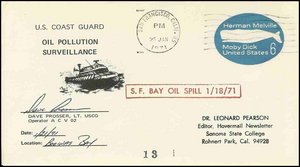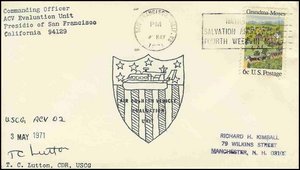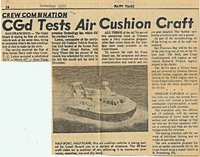CG ACV 02
Ship Name and Designation History
This section lists the names and designations that the ship had during its lifetime. The list is in chronological order.
This section lists active links to the pages displaying covers associated with the ship. There should be a separate set of pages for each name of the ship (for example, Bushnell AG-32 / Sumner AGS-5 are different names for the same ship so there should be one set of pages for Bushnell and one set for Sumner). Covers should be presented in chronological order (or as best as can be determined).
Since a ship may have many covers, they may be split among many pages so it doesn't take forever for the pages to load. Each page link should be accompanied by a date range for covers on that page.
- Covers Page 1 (1970-73)
Postmarks
This section lists examples of the postmarks used by the ship. There should be a separate set of postmarks for each name and/or commissioning period. Within each set, the postmarks should be listed in order of their classification type. If more than one postmark has the same classification, then they should be further sorted by date of earliest known usage.
A postmark should not be included unless accompanied by a close-up image and/or an
image of a cover showing that postmark. Date ranges MUST be based ONLY ON COVERS IN
THE MUSEUM and are expected to change as more covers are added.
>>> If you have a better example for any of the postmarks, please feel free to replace the
existing example.
|
Postmark Type |
Date From to Date To |
Thumbnail Link To Postmark Image |
Thumbnail Link To Cover Image |
|---|
|
USPS Machine |
1970-12-10 |
 |
N/A |
First Day of Service. San Francisco Bay Training Area.
|
USPS Machine |
1971-01-25 |
 |
N/A |
San Francisco Bay Oil Spill January 18 1971, cover is dated January 21 1971.
|
USPS Machine |
1971-01-30 |
 |
N/A |
San Francisco Bay Training Area.
|
USPS Slogan |
1971-03-12 |
 |
N/A |
San Francisco Bay Training Area.
|
USPS Slogan |
1971-05-03 |
 |
N/A |
San Francisco Bay Training Area.
|
USPS Slogan |
1973-07-06 |
 |
N/A |
San Francisco Bay Training Area.
|
N/A |
1970-11 |
 |
 |
Article from "Navy Times" November 1970 and a undated photo.
Other Information
From Wikipedia and
38-Foot Air Cushion Vehicle (US Coast Guard):
Patrol Air Cushion Vehicle (PACV), also known as the Air Cushion Vehicle (ACV) in Army and Coast Guard service.
Based on the Bell Aerosystems SK-5 hovercraft; a licensed version of the British Saunders-Roe
(later, British Hovercraft Corporation) SR.N5 hovercraft.
Used as a patrol boat in marshy and riverine areas during the Vietnam War between 1966 and 1970.
Six hovercraft were built, three for the Army and three for the Navy.
Two of the Army's three hovercraft were destroyed by the Viet Cong.
Transferred to USCG for evaluation in 1969 and overhauled in 1970 by Transportation Technology Inc.
Delivered to the Coast Guard in Oct 1970, Dec 1970, and Feb 1971.
The first two were initially stationed at Ft. Point Coast Guard Station in San Francisco.
The third was sent to Point Barrow, Alaska for arctic trials and then sent to St. Ignace Coast Guard Station on Lake Huron.
In use until 1975
Also see USCG Hovercraft: 38-Foot Air Cushion Vehicle (ACV), the actual evaluation report at AIR CUSHION VEHICLE EVALUATION by Thomas C. Lutton, and
the article Cavalry Afloat: The 39th Cavalry Platoon in the Mekong Delta by Captain Kevin Keaveney pages 12-19 in the July-August 1993 issue of "ARMOR" published by the U.S. Army Armor Center at Ft Knox, Kentucky.
If you have images or information to add to this page, then either contact the Curator or edit this page yourself and add it. See Editing Ship Pages for detailed information on editing this page.
Copyright 2024 Naval Cover Museum
